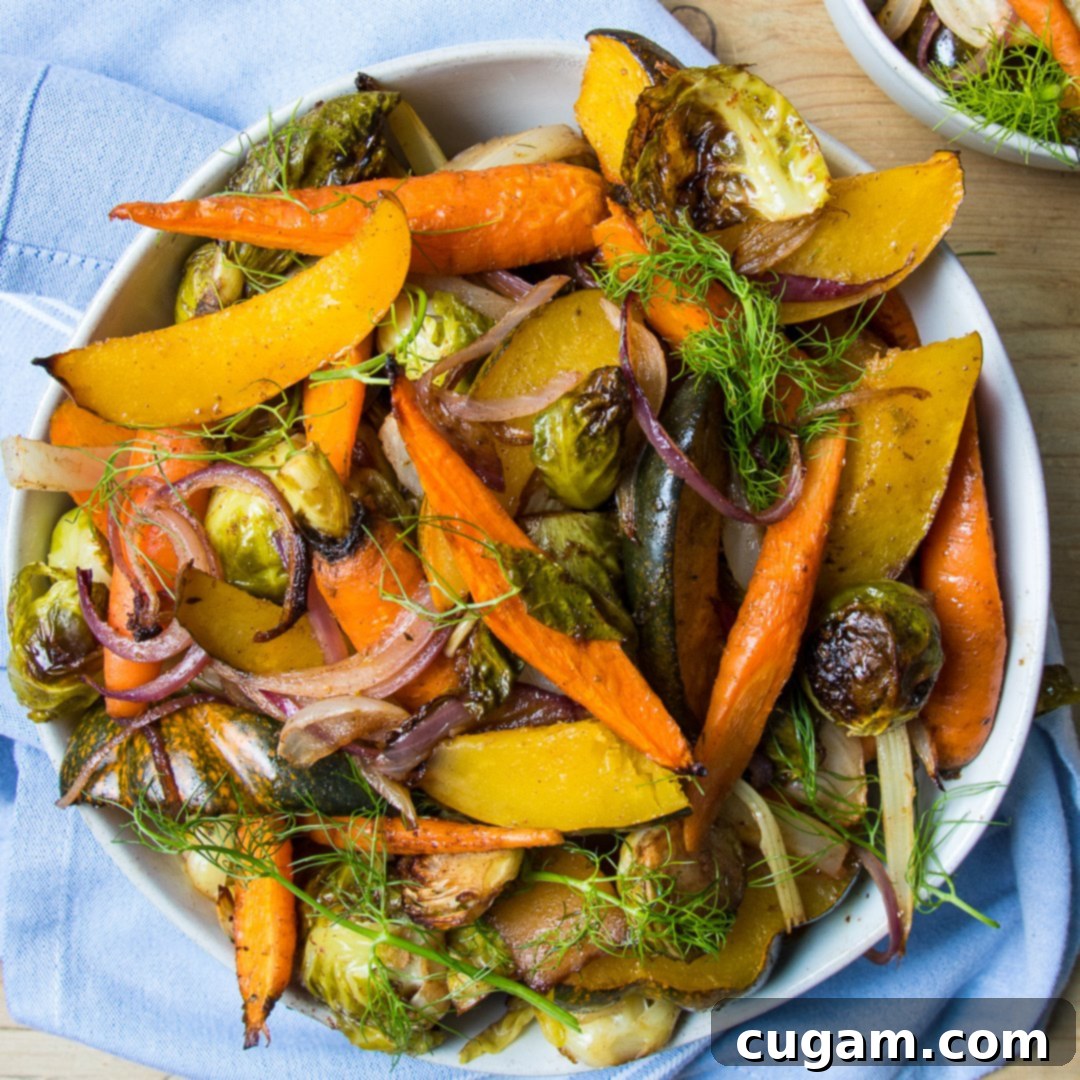Easy Sheet Pan Balsamic Roasted Root Vegetables: A Healthy & Flavorful Side Dish
Discover the ultimate vegetable side dish that combines stunning presentation with incredible ease! This recipe for Balsamic Roasted Root Vegetables utilizes a simple sheet pan method to create a naturally vegan, gluten-free, healthy, and incredibly tasty addition to any meal. Whether you’re planning a festive holiday feast like Thanksgiving or simply looking for a wholesome weeknight side, these caramelized veggies are guaranteed to impress.
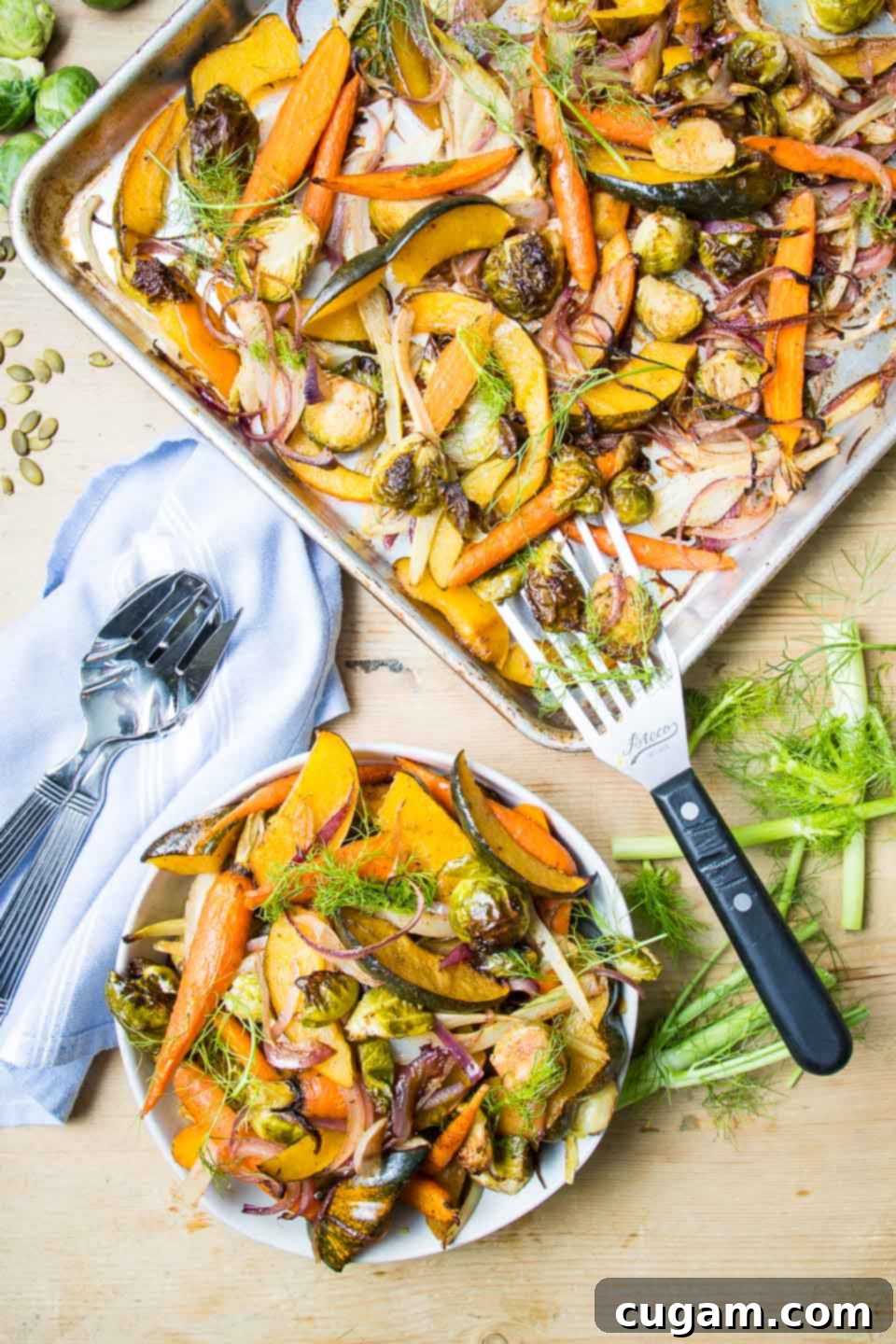
If your culinary quest leads you to a side dish that works as hard as you do – delivering equally on flavor, visual appeal, nutritional value, and effortless preparation – then your search ends here. This Balsamic Roasted Root Vegetables recipe embodies all these qualities and more. With just one sheet pan, a few minutes of hands-on prep, and the magic of your oven, humble root vegetables are transformed into a vibrant and delicious masterpiece. It’s the perfect, stress-free accompaniment for any occasion, from an elaborate holiday spread to a simple family dinner.
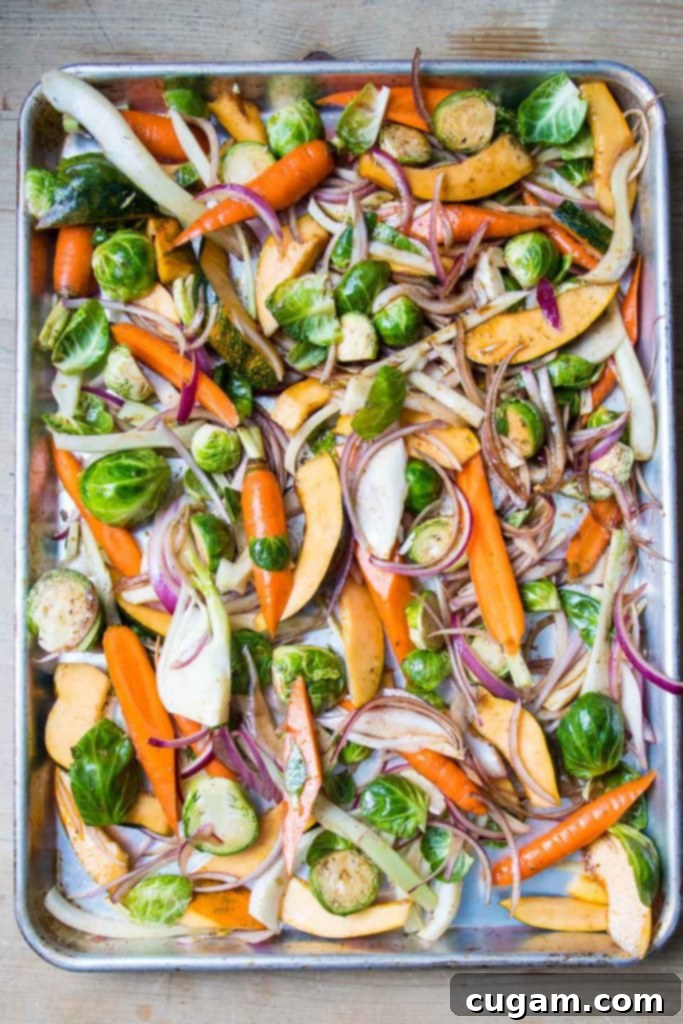
Why Roasting is the Best Way to Enjoy Vegetables
There’s something truly magical about high-temperature roasting that unlocks the hidden potential of vegetables. The dry heat caramelizes their natural sugars, intensifying their sweetness and creating beautifully browned, slightly crispy edges that are simply irresistible. This method not only enhances their flavor but also adds a delightful texture contrast that can make even the most vegetable-averse individuals eager for a second helping. For this recipe, we focus on a medley of seasonal root vegetables that lend themselves perfectly to this transformative cooking technique.
A Rainbow of Nutrients: The Chosen Root Vegetables
For this particular sheet pan creation, I’ve selected a colorful and flavorful mix of acorn squash, fennel, Brussels sprouts, carrots, and red onions. Each vegetable brings its unique texture, sweetness, and earthy notes to the ensemble, creating a harmonious and visually appealing dish. I especially appreciate how their vibrant hues coordinate to create an artful presentation, especially when cut into substantial, rustic chunks. The larger pieces not only look more appealing but also hold up better during roasting, developing tender interiors and wonderfully caramelized exteriors.
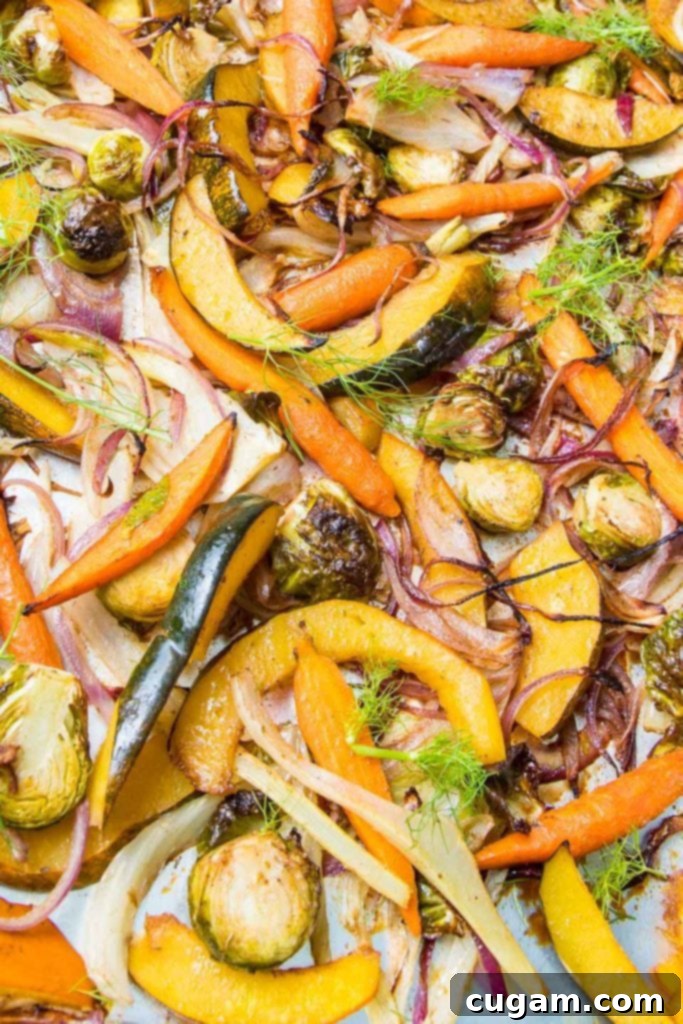
Are Balsamic Roasted Root Vegetables Healthy? Absolutely!
This recipe for balsamic roasted root vegetables is not just a feast for the eyes; it’s a powerhouse of nutrition. The vibrant array of colors on your plate signifies a rich spectrum of vitamins, minerals, and antioxidants, making this dish as good for your body as it is for your taste buds. It’s truly remarkable how something so beautiful can be so incredibly nutrient-dense.
- Acorn Squash: A fantastic source of dietary fiber, which aids digestion and promotes satiety. It’s also packed with Vitamin C, crucial for immune health, and essential minerals like potassium and magnesium, supporting heart health and muscle function.
- Carrots: Renowned for their high beta-carotene content, a powerful antioxidant that the body converts to Vitamin A, vital for vision and skin health. They also provide fiber, Vitamin K for blood clotting, and various other beneficial antioxidants.
- Fennel: This aromatic vegetable is loaded with fiber, contributing to gut health, and rich in potassium, folate, and Vitamin C. Its unique phytonutrients offer anti-inflammatory benefits and digestive support.
- Brussels Sprouts: These mini cabbages are nutritional champions, rich in fiber, multiple vitamins (especially K and C), minerals, and potent anti-oxidants that help protect cells from damage and support overall wellness.
- Purple Onions (Red Onions): Beyond their beautiful color, purple onions contain powerful compounds like anthocyanins and quercetin. These compounds are known to fight inflammation, decrease triglycerides, and help reduce cholesterol levels, contributing to cardiovascular health.
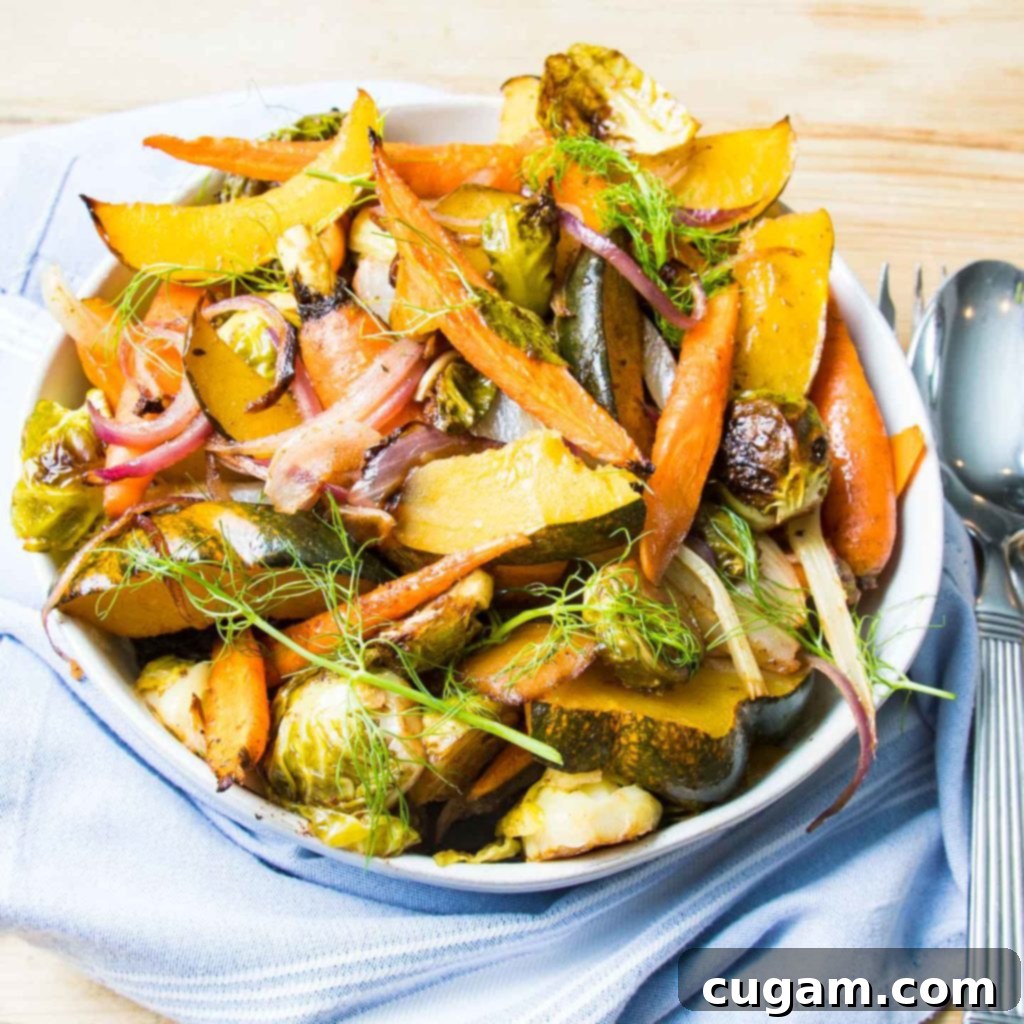
Here’s a wonderful opportunity to nourish yourself and your loved ones with a dish that is as effortless to prepare as it is aesthetically pleasing. Sometimes, beauty truly does come with brains… or at least, a whole lot of substance!
How to Cut Acorn Squash with Ease
For many years, the idea of preparing a whole squash felt daunting to me. My first foray into acorn squash involved making an easy mashed version, which was delicious and conveniently bypassed the need for slicing. However, everything changed when I discovered that roasted acorn squash skin is not only edible but also adds a fantastic texture and extra nutrients! With a truly sharp chef’s knife in hand, I shed my intimidation and haven’t looked back. Preparing acorn squash for roasting is surprisingly simple.
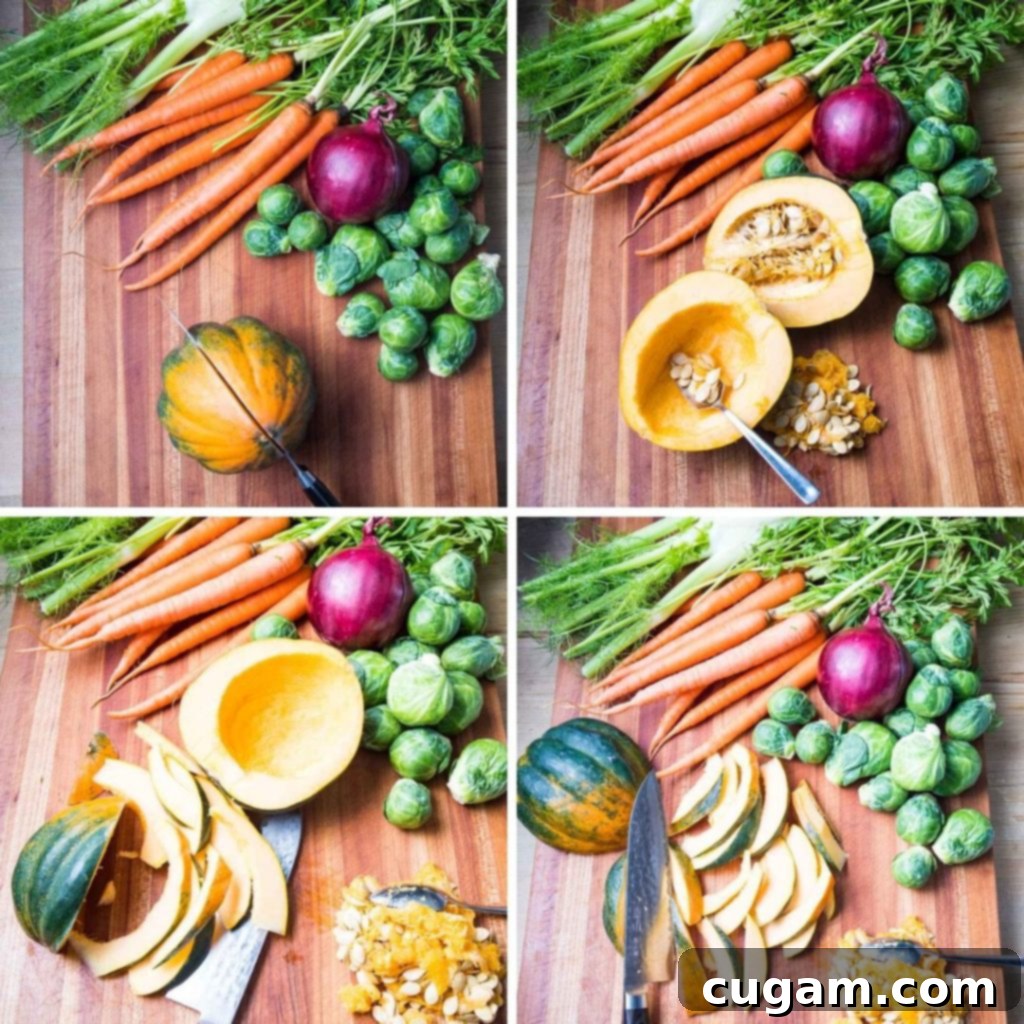
- Stabilize First: Begin by thinly slicing off the top, including any stem if it’s still attached. This creates a flat, stable surface, allowing you to place the squash securely on your cutting board without it rolling or wobbling – a crucial step for safety.
- Halve the Squash: With your sharp knife, carefully cut through the squash from one end to the other, halving it lengthwise.
- Remove Seeds: Use a spoon (a grapefruit spoon works exceptionally well) to scoop out the stringy pulp and seeds from the center of each half. Don’t discard the seeds! They can be cleaned, dried, and roasted in the same way you would prepare pumpkin seeds for a crunchy, healthy snack.
- Slice into Wedges: Lay the flat (cut) side of each squash half down on the cutting board. Slice each half into desired wedges. For this recipe, I recommend larger, more substantial chunks, usually about ½ to ¾ inch thick at their widest point. Remember, there’s no need to peel the skin!
How to Trim and Slice Fennel: Demystifying This Aromatic Bulb
If fennel has ever seemed like a mysterious or complicated vegetable to prepare, rest assured, it’s remarkably straightforward to trim and slice. Its delicate, anise-like flavor mellows beautifully when roasted, adding a unique aromatic depth to the vegetable medley.
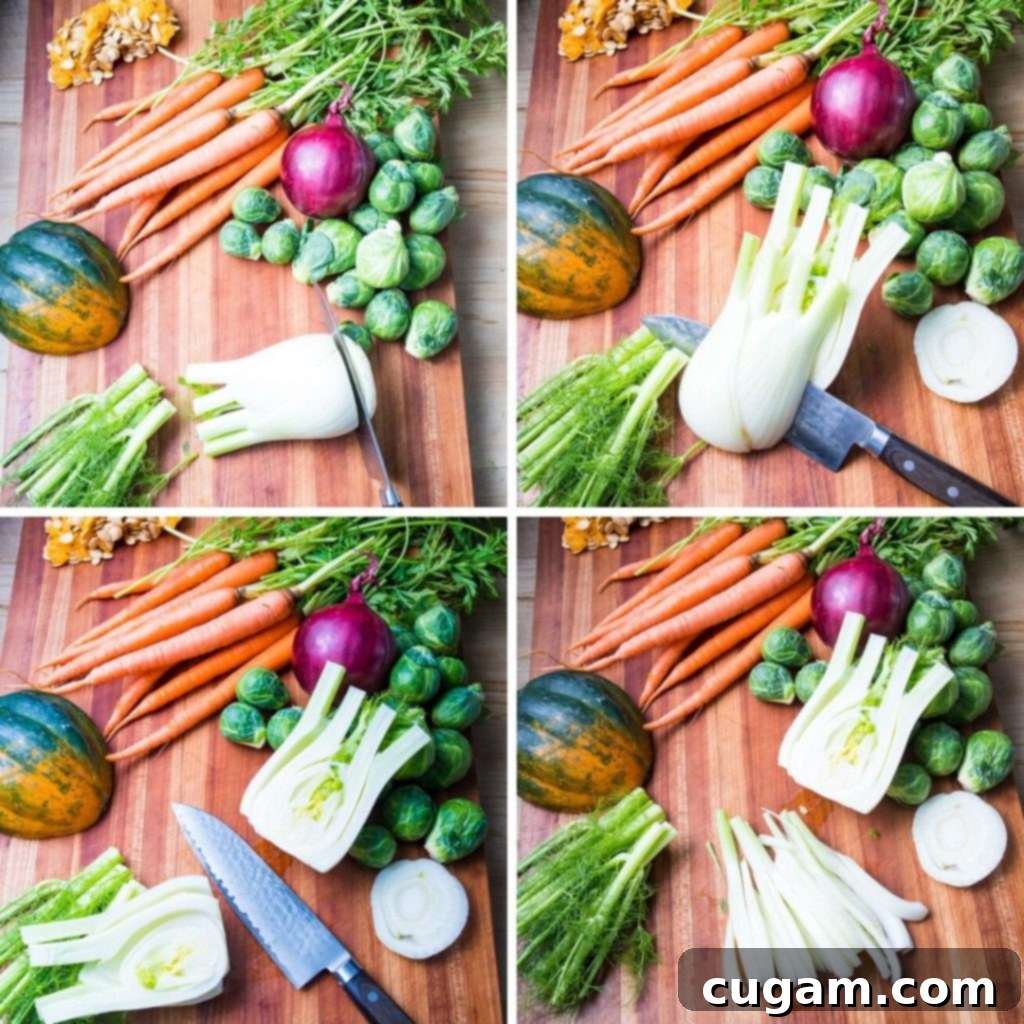
- Remove Fronds: First, cut off the feathery fronds from the top of the bulb. These delicate leaves are edible and make a wonderful, fresh garnish for the roasted vegetables once they come out of the oven.
- Trim the Base: Next, trim off the woody bottom core of the fennel bulb. This hard section is generally not pleasant to eat. Once trimmed, stand the fennel bulb upright on this newly flat surface.
- Halve the Bulb: Cut the bulb in half lengthwise through the center.
- Slice: Place each cut side down on the cutting board and slice into your desired thickness. For roasting, I prefer slices that are about ¼ to ½ inch thick, allowing them to soften and caramelize nicely without becoming mushy.
The Balsamic Marinade: A Symphony of Flavors
The secret to these incredibly flavorful roasted root vegetables lies in the simple yet powerful balsamic marinade. This glaze not only coats the vegetables in a layer of deliciousness but also aids in their caramelization, bringing out their natural sweetness and adding a beautiful tang. Each ingredient plays a crucial role:
- Olive Oil: The base of our marinade, ensuring even heat distribution and preventing sticking. It also contributes healthy fats and a subtle, fruity flavor.
- Balsamic Vinegar: The star of the show! Its rich, sweet-tart profile provides depth and a beautiful sheen to the roasted vegetables as it reduces and caramelizes in the oven.
- Maple Syrup: A natural sweetener that enhances the vegetables’ inherent sweetness and helps create those coveted crispy, caramelized edges. It’s a healthier alternative to refined sugars.
- Garlic: Freshly pressed garlic infuses the entire dish with an aromatic punch that complements the earthy root vegetables beautifully.
- Cinnamon, Cumin, & Oregano: This blend of spices adds warmth, a hint of exoticism, and an herbaceous note, elevating the flavor beyond a basic roasted vegetable dish. The cinnamon might sound unusual, but it works wonders with the sweetness of the squash and carrots!
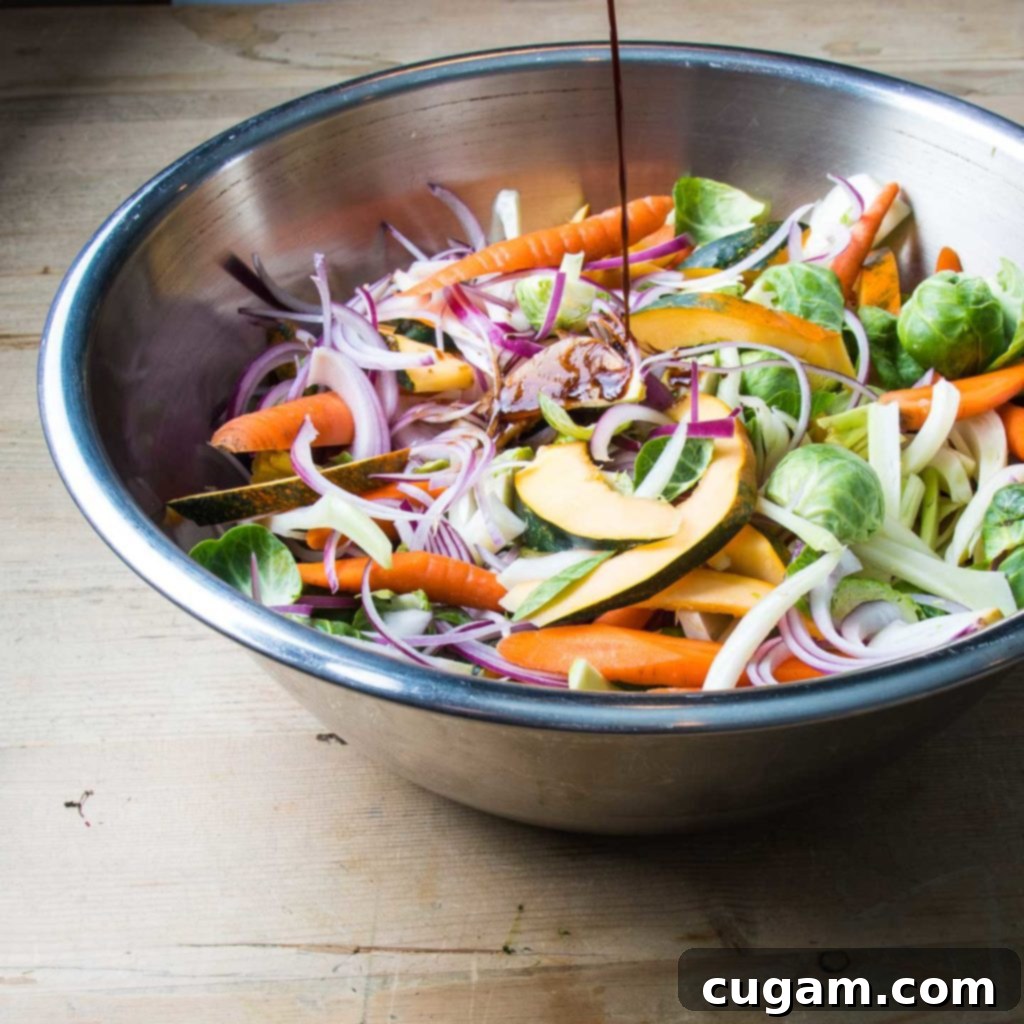
The Magic of the Sheet Pan: Easy & Efficient Cooking
One of the greatest advantages of this recipe is its reliance on the sheet pan method. This technique simplifies meal preparation, making cleanup a breeze and ensuring consistent cooking. For optimal results, a few key tips are essential:
- Don’t Overcrowd: This is perhaps the most important rule of sheet pan roasting. Vegetables need space to breathe and roast properly. If your pan is too crowded, the vegetables will steam instead of caramelize, resulting in a less desirable texture. Use two baking trays if necessary to ensure everything is in a single layer.
- Uniform Cutting: While we aim for rustic chunks, try to cut your vegetables into roughly similar sizes. This ensures they cook evenly and are all tender at the same time.
- High Temperature: Roasting at 425°F (220°C) is key to achieving that beautiful caramelization and tender-crisp texture.
- Season Generously: A good sprinkle of coarse sea salt and freshly ground black pepper before roasting will enhance all the flavors.
A Side Dish That Steals the Show, Especially for Thanksgiving
Thanksgiving menus often come with a long list of traditional expectations, making it challenging to introduce new dishes. Many guests have their steadfast favorites that simply cannot be omitted. Vegetables and healthy food sometimes struggle to make it to the top of everyone’s “must-have” list. Years ago, I discovered that offering a vibrant, flavorful vegetable medley like this is the perfect solution. It allows me to effortlessly incorporate a bounty of nutrition and variety, appealing to diverse tastes and offering a refreshing counterpoint to richer holiday fare. This beautiful bowl of goodness is more than just a side dish; it’s a star in its own right, easily holding its own amidst a crowd of contenders.
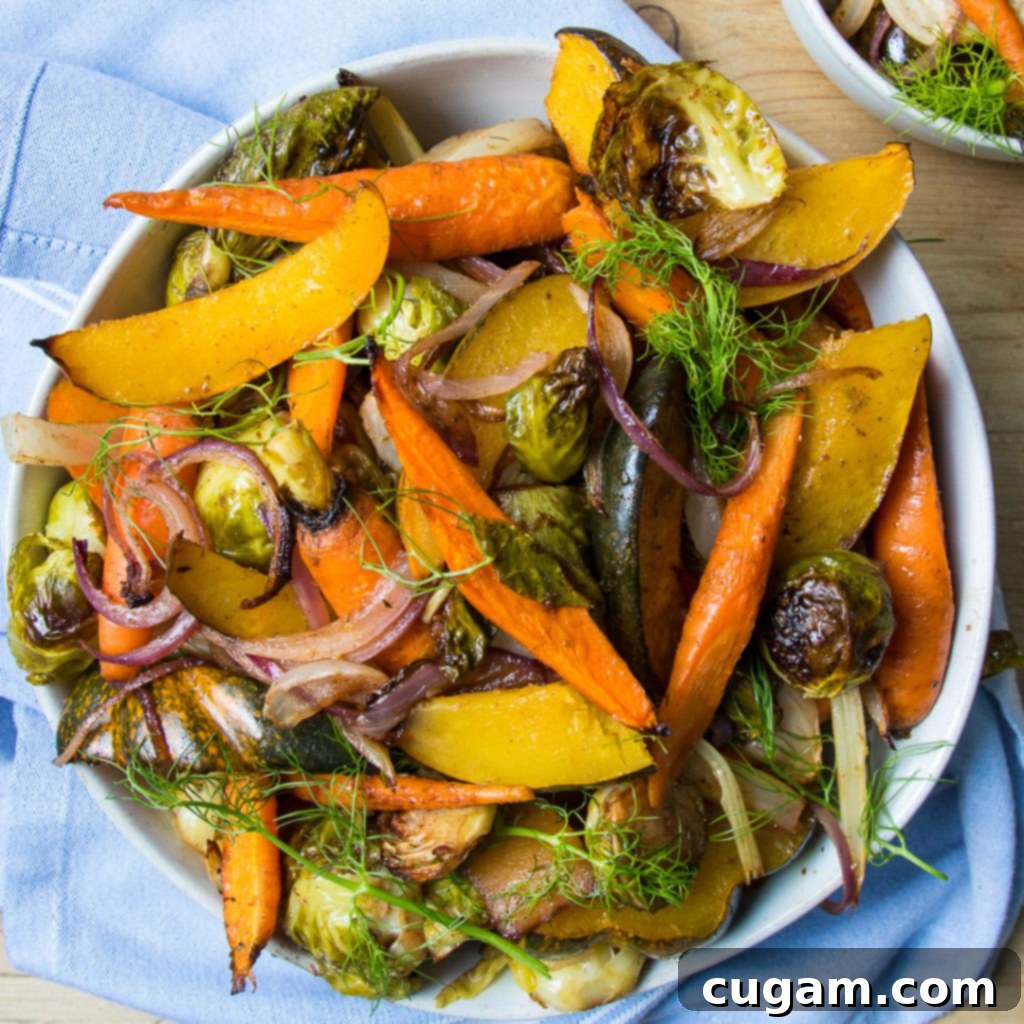
Did you know commenting and rating recipes is one of the best ways to support your favorite food bloggers? If you made this recipe, please consider a five-star rating below and leave a comment sharing your experience. Also, we’d love to see your creations! Please share your photos on Instagram by tagging me @dkhealthcoach and using the hashtag #debraklein. Your support helps us continue sharing delicious, healthy recipes!
📖 Recipe: Balsamic Roasted Root Vegetables
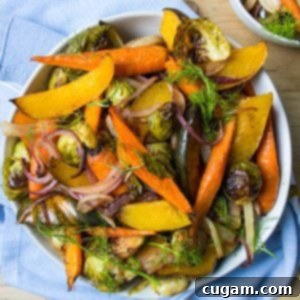
Balsamic Roasted Root Vegetables
Debra Klein
Rate this Recipe
📌Pin Recipe
10
30
40
Side Dish
Healthy
10 servings
129 kcal
Equipment
-
Stainless Steel Baking Sheets
-
Balloon whisk
-
Global 8″ Chef’s Knife
-
Extra Large Bamboo Cutting Board
-
Stainless steel mixing bowls
-
Garlic press
Ingredients
Vegetables
- 1 acorn squash
- 1 large bulb fennel
- 1 large purple onion
- 1 lb. carrots
- 1 lb. Brussels sprouts
- Coarse Sea Salt + Pepper to taste
Marinade
- ¼ cup olive oil
- 2 Tablespoons balsamic vinegar
- 1 Tablespoon maple syrup
- 3 cloves garlic pressed
- 1 teaspoon cinnamon
- 1 teaspoon cumin
- ½ teaspoon oregano
Instructions
-
Preheat your oven to 425°F (220°C).
-
Prepare your vegetables and place them in a large mixing bowl.
SQUASH: Halve the acorn squash, scoop out the seeds with a spoon, then place cut side down and slice into long, thin wedges (about ½ to ¾ inch thick).
FENNEL: Trim off the fronds from the top (save for garnish) and a thin slice off the bottom core. Cut the bulb in half lengthwise, then slice each half into thin pieces (about ¼ to ½ inch thick).
ONION: Halve the purple onion and then slice it thinly.
CARROTS: Cut the carrots into long spears or chunks of similar size to the other vegetables.
BRUSSELS SPROUTS: Trim the woody bottoms of the Brussels sprouts. Halve any larger sprouts to ensure even cooking.
-
Prepare the Marinade: In a small bowl, whisk together the olive oil, balsamic vinegar, maple syrup, pressed garlic, cinnamon, cumin, and oregano until well combined. Pour this delicious marinade over the prepared vegetables in the large bowl. Toss thoroughly to ensure all the vegetables are evenly coated.
-
Arrange for Roasting: Transfer the marinated vegetables to a large, rimmed baking sheet, spreading them out in a single layer. It’s crucial not to overcrowd the pan, as this will steam the vegetables instead of roasting them. If necessary, use two baking trays to ensure adequate space. Sprinkle generously with coarse sea salt and freshly ground black pepper to taste.
-
Roast to Perfection: Roast the vegetables in your preheated oven for 30 minutes, or until the squash and carrots are tender when pierced with a fork, and the edges are beautifully caramelized. You can toss them gently halfway through cooking for more even browning. Serve immediately and garnish with fresh fennel fronds if desired.
Notes
STORING LEFTOVERS: Leftover roasted vegetables can be stored in an airtight container in the refrigerator for up to 3-4 days.
REHEATING: To reheat, spread the leftover veggies on a baking sheet and warm them in a 400°F (200°C) oven for about 10-15 minutes, or until heated through and slightly re-crisped. This helps maintain their texture better than microwave reheating.
Nutrition
Calories: 129kcal
Carbohydrates: 15g
Protein: 2g
Fat: 8g
Saturated Fat: 1g
Polyunsaturated Fat: 6g
Sodium: 44mg
Fiber: 4g
Sugar: 5g
Note
The nutrition calculations were done using online tools and are estimates. To obtain the most accurate representation of the nutritional information in any given recipe, you should calculate the nutritional information with the actual ingredients you used. You are ultimately responsible for ensuring that any nutritional information is accurate, complete and useful.
Did you make this recipe?
Please leave a review below, then snap a picture and tag me @dkhealthcoach or use hashtag #dkhealthcoach on Instagram so I can see it!
